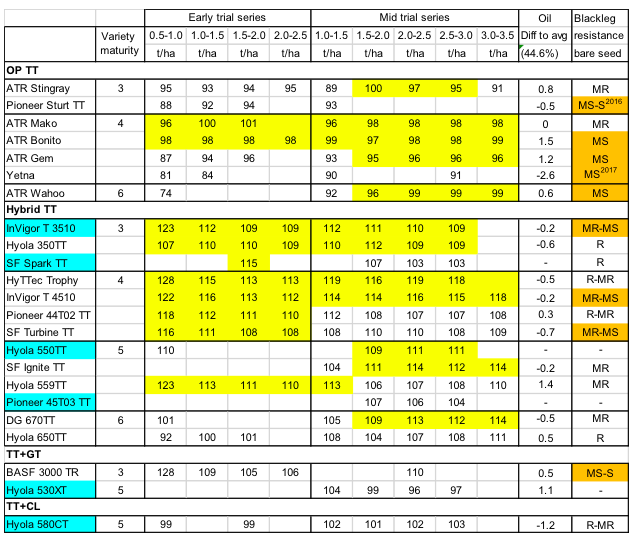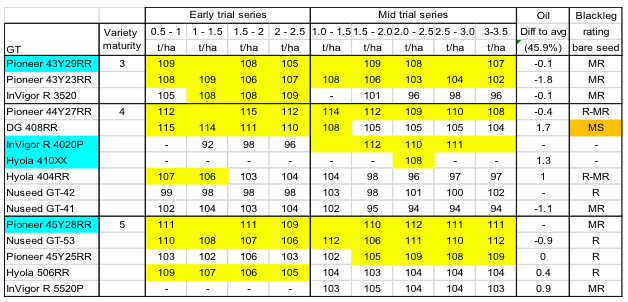New canola releases and NVT yields of current canola varieties
Author: Jackie Bucat, DPIRD | Date: 26 Feb 2019
Key Messages
Open pollinated (OP) Triazine Tolerant (TT) canola continues to be the mainstay of WA canola production with 67% of the WA crop area in 2018. Glyphosate Tolerant (GT) hybrid varieties comprise 25.5% of the canola area and hybrid TT varieties 5%.
With the advent of the new TruFlex trait we refer to the Glyphosate tolerant (GT) group, which includes both Roundup Ready and TruFlex varieties. TruFlex varieties have an extended glyphosate application window and greater flexibility in application rates.
The overall highest yielding hybrid TT varieties were HyTTec Trophy and InVigor T4510, and the highest yielding glyphosate tolerant (GT) varieties were Pioneer 44Y27 and Pioneer 45Y28, across low to high yielding sites and short to long season environments in the 2014-18 NVT MET analysis.
Ten new canola varieties are available for the 2019 season, giving growers more choice:
- A new combination, TT+CL herbicide tolerance (Hyola 580CL)
- New varieties in TT, GT and TT+GT herbicide tolerance groups
- New varieties across the maturity range, notably two new early series TT hybrids to join Hyola 350TT
- Varieties with new trait combinations include, TruFlex (Hyola 410XX, Hyola 530XT), PodGuard (InVigor R4020P) and a combination of both (InVigor R4022P).
However, here were no open pollinated TT varieties released in 2018
Aim
To introduce new varieties and to present performance information (yield, oil and blackleg resistance) for current canola varieties to assist growers selecting the most suitable variety for their situation, according to expected yield and season length. A brief report of 2018 NVT results is included but users should focus on the results from the long term Multi-Environment Trial (MET) analysis.
Trends in WA canola production
There has been a general decline in the proportion of TT OP canola varieties, from 71% in 2015 to 67% in 2018. The proportion of glyphosate tolerant (GT) hybrids has remained relatively constant, apart from 2017, but there has been a recent increase in the proportion of TT hybrids, to 5.3% in the 2018 season (Table 1).
In 2017 there was a sizeable increase in the area of canola grown. This extra area was largely sown with OP TT varieties. There was also a slight reduction in the total area of GT varieties. These factors caused a lower proportion of GT canola in the 2017 season.
In 2018, More than half of the WA canola area was sown to ATR Bonito (53%), similar to the proportion sown in 2017. The proportion of ATR Stingray declined from 13% in 2017 to 6% in 2018. The largest area of hybrid TT varieties were Hyola 559TT, InVigor T4510 and Pioneer 44T02 (TT). The largest area of glyphosate tolerant varieties were Hyola 404RR, Pioneer 43Y23RR, Nuseed GT-53, Pioneer 44Y27RR and Pioneer 45Y25RR.
Table 1. Proportion (% total area) of canola herbicide systems in WA (Data courtesy of CBH Group).
Canola type | 2015 | 2016 | 2017 | 2018 |
|---|---|---|---|---|
TT OP | 70.9 | 71.5 | 78.2 | 67.0 |
GT Hy | 23.7 | 22.5 | 17.9 | 25.5 |
TT Hy | 1.3 | 2.5 | 1.5 | 5.3 |
TT+GT Hy | 1.7 | 1.5 | 0.9 | 0.9 |
2018 NVT results
There were 36 successful NVT trials in 2018: 17 TT trials, 11 GT trials, and 8 CL trials. The average yields of TT varieties in the medium to long season environments (Mid TT series) ranged from 1.4 t/ha at Scaddan and Munglinup to 2.9 t/ha at Williams. In the shorter season environments (Early TT series) yields ranged from 0.6 t/ha t Hyden to 2.2 t/ha at Buntine. Trials were lost at Greenough due to snails, Dandaragan due to early water damage causing poor establishment, Mt Madden due to drought, patchy establishment and weeds, and at Jerramungup and South Stirlings due to sand blasting early in the season.
Highest yielding TT varieties in the 2018 Mid NVT were HyTTec Trophy, InVigor T4510 and Hyola 550TT. Williams was the highest yielding trial and both HyTTec Trophy and Hyola 550TT recorded yields of 3.23t/ha. In the Early TT trials, highest yielding varieties were SF Spark (TT) (present in only a single Early series trial), InVigor T 4510, HyTTec Trophy and Hyola 559TT.
The highest yielding GT variety in the 2018 NVT Mid RR series was Nuseed GT-53. It was the top ranked variety in trials at Bolgart, Katanning, Kojonup and Kendenup and second ranked at Gibson. Pioneer 44Y27RR and Pioneer 45Y25 were the next highest yielding varieties. In the Early series 2018 NVT trials, the top yielding varieties were Pioneer 44Y27, DG408RR and Nuseed GT-41.
However, the best data source for making variety choices is the long term NVT Multi-Environment Trial (MET) analysis, which is an analysis of multiple sites over multiple years. These are reported in the following sections.
TT varieties
New TT varieties
- InVigor T3510- high yielding, early maturity variety, MR-MS blackleg rating.
- SF Spark TT- early maturity variety with very high yield in the single early series NVT trial (Table 2), and excellent blackleg resistance (R).
- Hyola 550TT- mid maturity, high yield performance in Mid series NVT, no official blackleg rating yet.
- Pioneer 45T03 TT- mid maturity variety, no official blackleg rating yet.
TT 2014-18 NVT MET analysis
The highest yielding varieties in the Mid NVT series 2014-2018 were HyTTec Trophy, InVigor T4510 and Hyola 350TT. There are a further 7 varieties within 2% of Hyola 350TT long term yields (Table 2).
Use Table 2 to select suitable TT varieties according to your expected yields, length of season environment (Early or Mid series) and expected blackleg pressure. Varieties are listed in approximate yield order, for each maturity group.
The open pollinated variety ATR Bonito is most widely grown but ATR Mako has stronger blackleg resistance, and should be considered for high blackleg pressure paddocks.
The hybrid TT varieties consistently out yield the open pollinated varieties. However these higher yields need to be balanced against higher seed costs with higher financial risk. Refer to the associated Research Update paper when deciding between OP and hybrid TT varieties (Manage risk when planning to grow hybrid TT varieties).
Combination herbicide tolerance varieties
New TT+GT variety
- Hyola 530XT- with a combination TT and TruFlex glyphosate resistance (Table 2).
Use TT + GT combination varieties for superior control of ryegrass and radish, compared with single herbicide tolerance types.
New TT+CL variety
- Hyola 580CT- the first release with this new combination of herbicide tolerance (Table 2).
Advanta seeds has assigned this variety a mid maturity for harvest. However, when sown in April at South Perth DPIRD phenology trial, it developed very quickly and flowered at a similar time to the early maturity varieties.
Use TT + CL combination where imidazolinone soil residues may affect yields or for additional control of barley grass brome grass or other weeds as per the Imidazolinone label.
Table 2. TT, TT+GT, TT+CL varieties: 2014-18 NVT MET yield (% trial average), oil and blackleg rating.

Blue shading on variety name indicates new varieties, yellow shading on NVT yield values highlights highest yielding selections for each maturity group.
Glyphosate tolerant varieties
New GT varieties
- Pioneer 43Y29RR- 3 series (early) maturity replacement for Pioneer 43Y23RR, with marginal yield benefit and higher oil percent. High NVT MET yields for both Early and Mid series trials.
- InVigor R4020P- 4 series (early-mid) maturity variety with Podguard from BASF. Yields were most competitive in the Mid series trials.
- Hyola 410XX- new TruFlex variety, with extended application window and more flexibility in glyphosate application rates. Single 2017 result available from NVT.
- Pioneer 45Y28RR - released in 2018 and expected to become available for the 2020 growing season
GT 2014-18 NVT MET analysis
Highest yielding RR varieties were Pioneer 44Y27RR and Pioneer 45Y28RR, then GT-53, followed by 43Y29RR, over all sites, for the long term MET analysis (Table 3).
Use the reference Table 3 to select suitable glyphosate tolerant varieties according to your expected yields, length of season environment (Early or Mid series) and expected blackleg pressure. Varieties are listed in approximate yield order, for each maturity group.
Table 3. Glyphosate tolerant varieties: 2014-18 NVT MET yield (% trial average), oil and blackleg rating.

Blue shading on variety name indicates new varieties, yellow shading on yield values highlights highest yielding selections for each maturity group.
Conclusion
Choosing your variety
When selecting your canola variety
- Choose your canola type for the rotational weed control needed
- Refer to the long term NVT results (Tables 2 and 3) to choose high yield varieties
- Match variety maturity to the expected season length (Early or Mid series of NVT)
- Match maturity to TOS and use a longer season variety for very early sowing and a shorter season variety for very late sowing
- Consider other benefits of value to you- blackleg rating, Podguard, TruFlex
- TT hybrids generally out yield OP varieties but have higher seed cost. Refer to associated paper (listed below), for further information about changing to hybrid TT varieties.
Further information
Bucat, J, and Seymour, M (2019) Manage risk when planning to grow hybrid TT varieties. In Proceedings of GRDC Agribusiness Research Update Conference, Perth, Western Australia
Acknowledgments
Yield results presented here are from the GRDC NVT program. The GRDC Blackleg management guide is the source of variety blackleg resistance ratings (Tables 2 and 3). For more information, refer to NVTonline.com.au and grdc.com.au/resources-and-publications/all-publications/publications/2018/blackleg-management-guide
Tactical break crop agronomy GRDC Project Number: DAW00227
Paper reviewed by Bob French, Martin Harries, Imma Farre and Mark Seymour
GRDC Project Code: DAW00227,
Was this page helpful?
YOUR FEEDBACK
